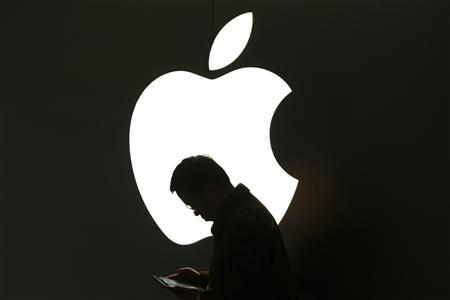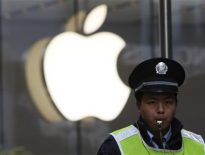(Reuters) – Sometimes even
eye-popping results are not enough.
Apple Inc’s shares rallied on Wednesday on the back of another spectacular
quarter that included soaring iPhone sales in China, but the naysayers are still asking if the most valuable American
company might need yet another revolutionary product in the next year to sustain its sizzling growth.

Apple store in downtown Shanghai in this March 16, 2012 file photo. REUTERS/Aly Song/Files
The skeptics certainly lost some credibility when the company’s shares surged 9 percent
on Wednesday, adding about $50 billion to Apple’s market value, but some have not been silenced.
Their case is based
on the law of large numbers – it is going to be more difficult for Apple to grow as fast the bigger it gets – and on the
unforgiving nature of the technology business that can turn heroes into has-beens overnight.
The bulls point to
emerging markets – in particular China, whose mobile market is the world’s largest and far from saturation – and upcoming
products like a 4G-enabled iPhone 5 and the oft-rumored Apple TV, as sustaining astonishing growth such as the near-doubling
of net income in its second quarter.
But the bears, with a longer-term view, fear that Google Android devices will
eventually put pressure on Apple’s margins in China as they have elsewhere, and wonder if Apple will be successful in
tacking on another blockbuster consumer device to its portfolio.
Sales in China, particularly, are key for Apple to
maintain its pace of revenue growth in the longer term, said Carolina Milanesi, consumer technologies analyst at
Gartner.
“That’s the big question,” she said, referring to market share in China. “From an affordability perspective,
I think the opportunity is there to allow it to maintain that growth or at least not to see an immediate drop in
sales.”
In products, “TV seems to be one that everybody is looking at,” she added.
Shorter term, over the next
year, some investors and Wall Street analysts note that Apple’s sales of the all-important iPhone could flatten out over the
next few quarters as consumers await the next version of the popular smartphone.
Apple’s own revenue forecast was
more conservative than usual for the fiscal third quarter, a period during which an upgrade of the iPhone or iPad are unlikely.
“We note that iPhone
product cycles appear to be getting increasingly pronounced, with fiscal first quarter and second quarter benefiting from
very strong iPhone 4S product cycles in the US and China, respectively,” said Toni Sacconaghi, analyst with Bernstein
Research, adding he expected the next couple of quarters to see “more sluggish unit sales.”
But for now, sales of 35.1
million iPhones in the last quarter saw Wall Street analysts extend their love affair with Apple shares with a slew of hiked
stock-price targets as concerns eased that the company was losing market share in the cut-throat smartphone market.
At
least 14 brokerages revised their targets on the stock by $40 on average, a day after the company posted a quarterly profit
that blew past Wall Street estimates.
Apple shares closed up almost 9 percent at $610 after touching an intraday high
of $618 for an advance of 10.3 percent, the biggest single-day percentage gain by Apple shares in more than three years. The
shares prior to the earnings had seen
an unusual two-week decline.
Apple, as 4.2 percent of the S&P 500, gave U.S. stocks a big shot in the arm on
Wednesday, driving the Nasdaq to its biggest single-day gain of the
year.
“Last night, Apple’s performance once again demonstrated how quickly Apple fever is spreading around the world
and this trend continues to drive meaningful upside in the company’s financial results,” said Topeka Capital Markets’ Brian
White, who raised his stock-price forecast to $1,111 from $1,001.
CHINA ROARS
Sales in greater China accounted
for about 20 percent of Apple’s $39.2 billion quarterly revenue, a three-fold increase from a year earlier. The numbers
showcased Apple’s sky-rocketing growth in China, which made up just 4.5 percent of its revenue in fiscal 2010.
Sales
there are on track to nearly double this year, with a combined revenue in the first two quarters of $12.4 billion. That is
almost level with revenue from China of $13.3 billion in all of fiscal 2011.
Giri Cherukuri, head trader and portfolio
manager for OakBrook Investments in Illinois, said Apple had room to grow in China but would also look to other developing
countries with large populations – such as India, Brazil and Russia – to keep up the pace of sales.
“They are
methodically just growing country by country, both just building Apple stores in these countries and building distribution,”
Cherukuri said. “That’s partly why you are getting strong numbers now. When a new iPhone or iPad comes out, they can rapidly
deploy those all over the world.”
In China, Apple has yet to seal a contract for the iPhone with China Mobile, the
world’s largest mobile operator in terms of subscribers, with 660 million users. A deal with the carrier for the next iPhone
has the potential to considerably boost iPhone sales in the country.
“The main challenge for Apple is to penetrate
China Mobile’s 600 million subscribers. The numbers look pretty good now, but would be much better with China Mobile,” said
Nomura analyst Huang Leping.
But doing business in China has its challenges. Apple has faced a raft of negative
publicity in China in recent years, including worker suicides at its supplier Foxconn Technology, accusations of
environmental pollution, and copyright and trademark infringement.
Now, Apple also needs to find a way to stop users
who hack into the iPhone’s software to download free apps or solicit services from e-commerce sites to download apps at a
fraction of their cost in the App Store or iTunes Store.
Many deep-pocketed companies have attempted to crack the
Chinese market, tempted by a large and growing middle class. But regulations that favor and protect local businesses, plus a
lack of understanding of the market, have stumped many.
Wal-Mart has struggled against local rivals. But other
companies — such as carmaker General Motors and KFC parent Yum Brands — have been more successful in penetrating the
market. In Yum’s case, China accounts for more than 40 percent of the company’s profit.
MARGINS
DELIGHT
Apple’s strong results on Tuesday came after a 13 percent decline in the company’s shares over the past
couple of weeks that erased about $78 billion from its market value.
Following the earnings announcement, analysts
discounted worries about rising competition and pricing pressures, noting the company’s stronger margins of 47.4 percent in
particular.
“Apple’s margin upside has the most important long-term implications for the story,” said Goldman analyst
Bill Shope, who raised his target price on the stock by $100 to $850.
Chief Executive Tim Cook took Apple’s helm
shortly before co-founder Steve Jobs died in October, and was immediately subjected to a discussion of whether he embodied
the same vision and foresight needed to keep the company at the forefront of innovation.
A smart TV – dubbed iTV by
Apple watchers – is seen as the next product to drive the next phase of growth. While Apple has neither confirmed nor denied
it was working on a TV, Jobs told his biographer, Walter Isaacson, about reinventing the television set and how he had
“cracked” it.
Many on Wall Street expect Apple’s version – and perhaps Jobs’s vision – to be unveiled later this
year or next year.
So strong is the speculation that investors are likely to be disappointed if Apple does not launch
a device for the living room, Cherukuri of OakBrook Investments said, adding however that a television-like product is
“pretty certain” at this point.
“It can’t just be a piece of hardware,” Gartner’s Milanesi said of the possible TV,
adding that it would have to “drive a similar replacement cycle as you see in the iPad or iPhone.”
(Additional
reporting by Melanie Lee in
Shanghai, Tenzin Pema and Himank
Sharma in Bangalore; Editing by Andre Grenon and Muralikumar
Anantharaman)




